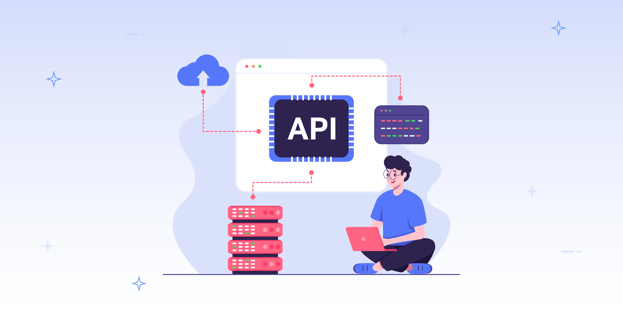
BLOG

BLOG
Businesses have gone mobile-first, and with good reason—people are spending more time and more money on their phones than ever before. For instance, in 2023, an estimated 66% or 2/3rds of all online orders were made from mobile devices. And in 2024, businesses are expected to spend $402 billion on mobile advertising.
Mobile apps have become the first choice for users for their online activities in banking, e-commerce, media streaming, social media, etc. Increasingly, mobile apps on smartphones ‘talk’ to each other.
According to a recent study, attacks on APIs have increased by 117% yearly. Even a single user data breach or a few hours of downtime can impact a business to millions of dollars. Businesses can no longer afford to allow the security of their mobile APIs to take a backseat.
We have grown accustomed to personalized and seamless user experiences across multiple apps. APIs power these interactions between mobile apps.
As mobile apps continue to grow, APIs have become ubiquitous, and their threat landscape has rapidly expanded.
Here’s why you should consider security for mobile APIs as mission-critical:

Raghunandan J, Appknox's Senior Product Manager, believes that:
"API security in mobile apps is essential to ensure reliable user experiences, maintain the integrity of data transactions, and ensure compliance with industry regulations.
Appknox supports developers by providing thorough security evaluations and continuous monitoring, helping them secure their APIs against evolving threats."
API security for mobile apps refers to the processes and tools used to protect the integrity of both owned and used mobile APIs and safeguard against attacks that seek to exploit sensitive data and/or disrupt services.
Security teams now focus exclusively on mobile app API testing and increasingly rely on application security testing software (mostly the SAST tools) to test and secure mobile APIs.
However, when it comes to their effectiveness in testing the security of mobile app APIs, app security testing software has limitations that make it less than ideal as a mobile app API testing tool.
The question that then confronts enterprises is, how do we test the security of mobile app APIs? The answer lies in automated application security testing.
Mobile app APIs are growing exponentially and becoming increasingly sophisticated.
Besides, manually testing a considerable volume of mobile APIs can be tedious and time-consuming, not to mention a huge drain on the security testing team's bandwidth. When it takes time to discover and resolve security vulnerabilities, security testing can hold up the production/release cycle.
In addition, the limitations of manual testing, such as incomplete coverage of APIs in security tests, leave the door open for attackers to exploit API security vulnerabilities. These issues pose a severe challenge to remediating the security posture of mobile app APIs.
Automating API security testing frees up critical resources and ensures a more robust security posture for your mobile APIs.
In particular, automated dynamic application security testing, or DAST, offers a practical approach to mobile app API testing as
Watch an on-demand webinar on the best practices of API security testing
Addressing API security threats is essential to protecting mobile apps from data breaches, unauthorized access, and malicious attacks. Some of the threats are:
Adopting an API security framework that everyone in the organization can align on helps contain security threats arising from the increased usage of APIs.
An API security framework outlines simple yet critical protocols related to using APIs. Let’s look at a three-step API security framework you can implement in your organization.
Continuous API discovery is essential to building and maintaining an up-to-date inventory of APIs in use in your organization. Lack of visibility into what APIs and how many are in use across your organization presents one of the biggest challenges to API security.
As APIs undergo changes and updates and new versions are released, API specifications must be updated so everyone understands what the API does.
In short, API discovery and specification are necessary for a comprehensive security assessment of all APIs in use at your organization.
The next step entails conducting the right type of security testing:
This is where API security automation tools truly shine, as they can quickly and dynamically find potential vulnerabilities within the API's authentication and encryption layers.
The final step of the API security framework is policy creation and enforcement. This requires answering two questions:
Although API policy enforcement was traditionally done at the network gateway layer, cloud and mobile architectures have forced developers to provide security aspects through SDKs and the dashboards of cloud service platform providers.
Choosing the right API security automation tool is key to ensuring a robust security posture for your organization.
Consider the following factors when evaluating an API security automation tool for your business:
Your security automation tool should
If the results of each API security test show many false positives, your engineering/ DevOps teams will need to filter the results to identify the actual security vulnerabilities manually.
The threat landscape for mobile APIs is constantly evolving. You need an API security automation tool that provides comprehensive security coverage against various known threats.
The tool should ensure preparedness against emerging threats by integrating with threat intelligence databases and receiving real-time updates.
When choosing an API security automation tool, account for the possibility that your product offerings will continue to grow. Your security testing efforts will need to scale to secure a growing number of mobile apps, APIs, endpoints, calls, and parameters.
Your engineering and DevOps teams might have built your security testing tech stack by combining numerous point-solution tools. However, the license costs for multiple tools make security testing expensive.
A good security testing automation platform consolidates your testing tech stack, replaces multiple disparate tools, and drastically reduces expenses on license fees.
When mobile API security testing proceeds slowly, discovering and resolving security threats takes a long time. This delays development cycles and time to market and affects the business's bottom line.
The right API security automation tool reduces the time to complete security tests by
Engineering and DevOps resource bandwidth takes a lot of work to come by.
Manually testing every permutation and combination of API calls, endpoints, and parameters can become a herculean task, and teams simply cannot allocate the time and resources required.
Automated API security testing is more accurate, helps you cover a larger attack surface in less time, and can ensure a robust security posture against emerging threats through frequent security scans.
Mobile app APIs are fast becoming the vector of choice for attackers. Enterprises must identify and resolve security vulnerabilities across their API inventory to safeguard against data breaches and/or service disruptions.
Here’s why developers and security researchers looking to build safe and secure mobile ecosystems rely on Appknox as their trusted API security testing partner (and why you should, too):
Appknox’s unique hybrid approach of ‘system plus human’ provides a holistic approach to maintaining a robust security posture. Integrating Appknox with threat intelligence databases ensures your mobile app APIs are safeguarded against known and evolving security threats.
In conclusion, if you are an enterprise looking to take control of your mobile app security, you need not look any further.
The key benefits of API security for mobile apps are:
Here’s how you can do it:
1. Use token-based authentication
Start by using OAuth 2.0 or JSON Web Tokens (JWT) to authenticate users. They enable stateless authentication, so your servers won’t need to store session data—making the process faster and more efficient.
2. Enforce strong password policies
Add multi-factor authentication (MFA) for another layer of protection. This makes it much harder for attackers to gain access.
3. Use HTTPS everywhere
Always use HTTPS to encrypt all API requests and responses to ensure that data can’t be intercepted while it’s being transmitted, keeping sensitive information safe.
4. Set permissions carefully
Role-based access control (RBAC) gives users access only to what they need. This helps minimize risk by ensuring that only authorized users can access sensitive parts of apps.
5. Rotate and expire tokens regularly
This keeps stolen tokens from being used for long, reducing the risk of misuse.
API vulnerability scans should target the endpoints actually used by mobile apps, not just documented backend services. This includes APIs embedded in APKs and IPAs that handle authentication, payments, notifications, and user data. Testing these endpoints reveals risks that attackers exploit outside traditional web flows.
Appknox’s VA extracts endpoints from Android and iOS builds and tests them with real authentication context to uncover security flaws that affect mobile workflows.
💡Pro tip: Mobile API scans must test real, app-used endpoints, not just documented APIs.
Teams should fix API vulnerabilities by prioritizing issues based on severity, data sensitivity, and exploitability. High-risk flaws, such as broken authorization and data exposure, should be addressed first to reduce the real attack surface in mobile applications.
💡Pro tip: Fix what reduces risk first. Authorization and data exposure issues are the most critical.
Yes, absolutely! Appknox runs API security tests specifically for mobile applications by analyzing APIs in the context of Android and iOS usage, covering risks such as token misuse, session replay, and insecure backend logic tied to mobile workflows.
Mobile apps require API tests tailored to mobile threat models.
Explore: Appknox Automated VA
Common API security testing challenges include
These issues are best addressed through mobile-aware endpoint discovery, proper token handling, and validating findings against real application behavior.
📌Note: Most API testing gaps stem from a lack of mobile context.
Most mobile apps require minimal configuration for API security testing.
Appknox supports token-based authentication and environment variables, enabling secure API testing without changing production app behavior or disrupting users.
📌Note: API testing should fit into existing mobile workflows seamlessly.
Remember that API testing should be integrated early into the development workflows. For this, embed automated API security tests within CI/CD pipelines and pre-production environments. As a result, APIs are tested continuously as they evolve, helping teams identify vulnerabilities before they reach production and reducing security bottlenecks late in the SDLC.
API security tests can be triggered automatically within CI/CD pipelines to run immediately after code changes or before deployment. This ensures vulnerabilities are detected early—when fixes are faster and less disruptive.
By integrating API security testing into pipelines, teams avoid late-stage surprises and reduce the cost of remediating security issues discovered post-release.
Organizations can verify API compliance by continuously testing APIs against security standards and regulatory requirements such as OWASP API Top 10, GDPR, and industry-specific mandates. Automated testing and audit-ready reports by Appknox ensure consistent enforcement of security policies, helping demonstrate compliance during internal and external audits.
API vulnerability scans for mobile app endpoints can be performed by dynamically analyzing API traffic generated during real app interactions. Automated DAST tools like Appknox identify exposed endpoints, test authentication and authorization flows, and detect vulnerabilities such as improper access control, data exposure, and input validation issues.
Mobile API security tests should be designed to reflect real-world mobile traffic patterns without slowing development or release workflows.
With Appknox, teams can:
Run targeted scans only on mobile-exposed and high-risk endpoints
Analyze session handling, token reuse, and device-bound authentication
Execute non-blocking API tests in parallel with CI/CD builds
Detect injection flaws, broken authorization, and data leaks without introducing runtime overhead
This approach ensures security testing remains fast, precise, and aligned with mobile performance expectations.
💡Pro tip: Secure mobile APIs without sacrificing speed by testing what mobile apps actually use, not the entire backend.
